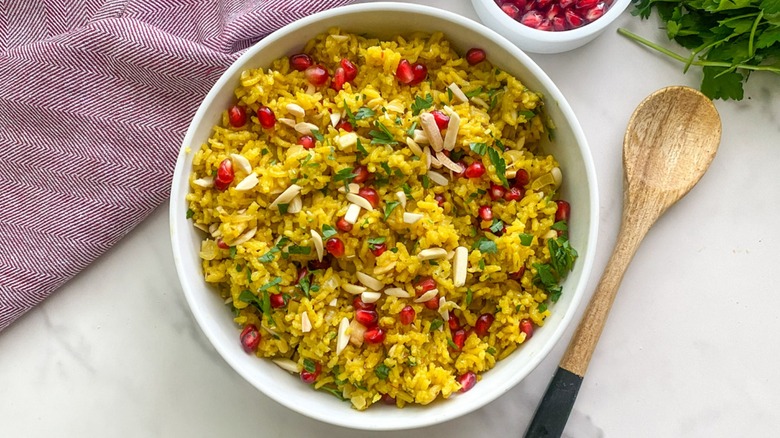The Secret Method For Beautifully Flavored Saffron Rice Pilaf
As a general matter, rice pairs well with saucy dishes because it absorbs adjacent aromas and flavors. However, rice pilaf requires needs no such saucy dish assistance. Indeed, by the time rice pilaf hits one's plate, it has already acquired all the sensory accoutrements it could ever need, thanks to its unique method of preparation. To wit, whereas ordinary rice is boiled in water, rice pilaf is simmered in a broth enhanced with aromatics such as onion, garlic, herbs, and spices. The result is a fluffy — and completely non-sticky — rice dish with a layered taste profile that would not otherwise be possible — and certainly not from simply using boiled rice to sop up sauce.
So, imagine our surprise when we discovered it's actually possible to elevate rice pilaf even further. And that is by affording the rice a long, slow roast in the oven while it simmers. Doing so unleashes complex, nuanced notes that enhance the end result immeasurably. In fact, we suspect we may never again make use of the world's most expensive spice, saffron, in any rice pilaf without leveraging this secret method that comes to us from Tasting Table recipe developer Miriam Hahn.
From our kitchen to yours
Before Hahn's Saffron Rice Pilaf Recipe, which makes brilliant use of oven roasting for a beautifully flavored pilaf, we were already toasting our rice before simmering. That step actually features prominently in Hahn's wonderful Garlicky Rice Pilaf Recipe, and it's as easy as toasting cumin seeds as you'd do when preparing garam masala.
Indeed, Hahn's secret method for beautifully flavored saffron rice pilaf starts with a brief pan-toasting of cumin seeds in an oven-safe pan before adding in the other aromatics (in this case, onion) and stirring in the rice to coat it. But what really distinguishes this method is that after stirring in bloomed saffron and broth, the pan is then placed in a hot oven to roast at 350 degrees Fahrenheit, which is hot enough to encourage the Maillard reaction for toasty caramelized goodness but not so hot that the rice is in any danger of drying out.
That being said, Hahn advises checking on your rice pilaf after 20 minutes, and adding more liquid if it has cooked down substantially. Your saffron rice pilaf should be tender and fluffy after another 10 minutes or so. At that point, it's time to take it out and fluff with a fork. All that's left now is to admire your work — but not before tossing in a handful of juicy, tangy, pomegranate seeds.

